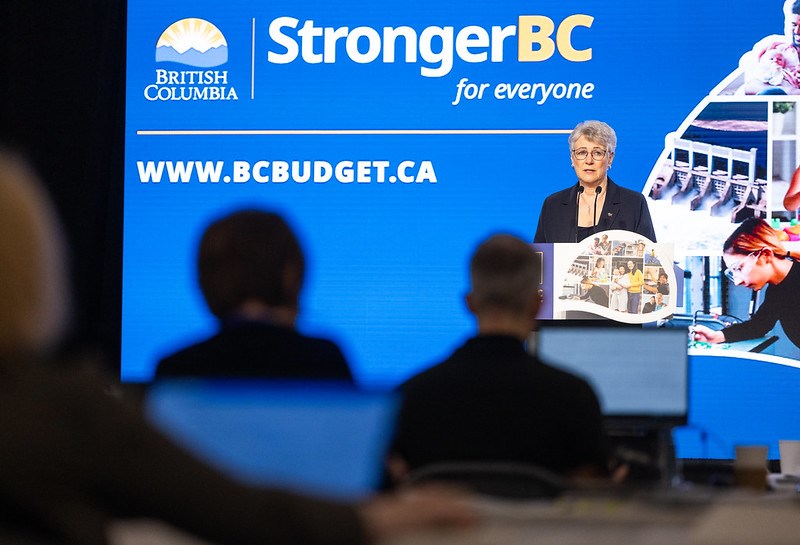The 2024 B.C. budget projects a $7.9 billion deficit this fiscal year — the largest deficit in B.C.’s history — and record deficits over the forecast horizon.
A deficit means that expenses exceed revenues, requiring the government to borrow the difference in financial markets. At 1.9 per cent of GDP, the deficit is significantly larger than last year’s which was then the largest among the provinces and second only to the federal government.
In October, the Bank of Canada governor underscored that “it’s going to be easier to get inflation down if monetary and fiscal policy are rowing in the same direction.” B.C.’s budget ignores those concerns and accelerates an already-unhelpful pace of spending and borrowing that is stimulative at a time when B.C.’s inflation rate is three per cent.
There is simply no reason to be running record deficits when unemployment is fairly low, the economy has little underutilized capacity and people are struggling to pay the bills because of inflation. People are watching their pennies; it seems only fair to ask governments to do the same.
The government’s capital spending jumps by $4 billion to $14 billion in 2024-25. Serial cost overruns on capital projects are a problem. Taxpayer-supported debt as a share of GDP rises to 21 per cent in 2024-25 and to 27.5 per cent by 2026-27, almost double what it was in 2018-19.
The province will spend $4.1 billion on debt servicing in 2024-25, representing 4.6 per cent of expenses. This is roughly equivalent to the child welfare budget or about half the school education budget. As they climb to 6.1 per cent of expenses by 2026-27, debt payments could start to constrain public service provision.
The economic outlook is sobering. Population growth keeps topline economic growth positive. However, looking through the veneer of population growth, B.C.’s GDP per capita is expected to fall by another two per cent in 2024, following a two-per-cent fall in 2023, meaning the economic pie is shrinking. By 2028, provincial GDP per capita is projected to be $931 lower than in 2022.
There has been almost no private sector job growth in B.C. since 2019. Major capital projects are winding down and, with a few exceptions, business investment is broadly weak. It is not sustainable for B.C. to rely on expanding public sector employment to keep total job growth positive.
The budget provides $100 million in tax relief for smaller businesses as the payroll exemption threshold for the Employer Health Tax is raised to $1 million from $500,000. Although the overall budget is inflationary, there are spending measures intended to partially offset cost-of-living pressures, including $370 million in electricity bill rebates. While the budget contains positive measures, the projection that real per-capita incomes in the province are on track to be almost $1,000 lower in 2028 than in 2022 should be ringing alarm bells. The government must prioritize getting B.C.’s economic pie growing again.
Where to begin? The government should set — and stick to — a fiscal anchor such as a plan to return to a balanced budget within three years, keeping provincial debt to no more than 20 per cent of GDP or keeping debt servicing costs to no more than three to four per cent of expenses.
Commendably, the budget introduces an Indigenous loan-guarantee program backed by up to $1 billion in government funds to help First Nations acquire equity stakes in projects in their territories. The program follows similar programs in Alberta, Saskatchewan and Ontario in recognizing that access to capital has long been a barrier to First Nations’ participation in economic development.
However, a headwind facing economic development more generally is the CleanBC Roadmap to 2030. Rethinking the CleanBC Plan — the short timelines, high-cost regulatory interventions and lack of revenue neutrality for the sharply-rising carbon tax — should also be a priority given the very heavy costs on the economy over the next six years according to the government’s own modelling.
Reconsidering the top personal income tax (PIT) rate would be another good place to start. B.C.’s top PIT rate is the fourth-highest of any Canadian province or U.S. state and kicks in at comparatively modest income levels, making it hard to retain and attract the skilled workers, innovators and entrepreneurs who are vital to a prosperous economy.
Overall, this budget comes with a steep price tag for young and future generations. B.C.’s fiscal situation is manageable, at least in the short term, but record deficits, hefty borrowing and debt-servicing costs and falling per capita incomes are cause for concern. S&P Global downgraded the province’s debt rating from AA+ to AA after last year’s budget. Bond ratings agencies will be scrutinizing this year’s fiscal plan even more closely. Future downgrades could spell higher costs for taxpayers in servicing the government’s ballooning debt.
David Williams, DPhil, is vice-president of policy at the Business Council of British Columbia.




